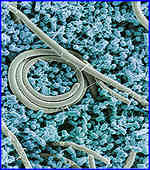



Tracking Antimicrobial Resistant Organisms
US - Antibiotics have been used for years to fight bacterial infections, but some bacteria are developing resistance to these antimicrobial drugs. Agricultural Research Service (ARS) scientists in Athens, Ga., are tracking antimicrobial resistance and seeking ways to minimize it.
Tracking Antimicrobial Resistant Organisms - US - Antibiotics have been used for years to fight bacterial infections, but some bacteria are developing resistance to these antimicrobial drugs. Agricultural Research Service (ARS) scientists in Athens, Ga., are tracking antimicrobial resistance and seeking ways to minimize it.
ARS microbiologist Paula Fedorka-Cray, research leader of the agency's Bacterial Epidemiology and Antimicrobial Resistance Research Unit at Athens, leads a team that is testing for antimicrobial resistance in food-borne microbes.
In these studies, bacterial samples are taken from sick farm animals, healthy farm animals and animal slaughter facilities. The lab's scientists then isolate, test and characterize more than 17,000 bacterial samples a year.
Patterns of resistance are difficult to discern because bacteria don't react predictably and uniformly to antibiotic treatment. For instance, there are many different types of Campylobacter, but each responds differently to antimicrobial drugs.
Another potentially harmful bacterium, Salmonella, has more than 2,400 different types, and each one appears to develop resistance to antibiotics at a different rate. Of all Salmonella types tested from 1997 to 2003, the rate of single-drug resistance has remained relatively stable at 9.5 percent of the samples.
However, the number of Salmonella types that are resistant to more than five drugs rose from 11 percent to 20 percent. Those that are resistant to more than 10 drugs rose from a scant 0.8 percent to almost 6 percent.
Fedorka-Cray's research group has developed the nation's largest descriptive database of resistant populations of bacteria recovered from animals over time. The data will be used to determine the probability that resistance will occur or be maintained if antibiotics are used. Changes in antibiotic use in food-animal production are being made in response to the development of resistance to the drugs.
Read more about the research in the March 2005 issue of Agricultural Research magazine.
Source: USDA Agricultural Research Service - 9th March 2005
 Cells of Salmonella enteritidis change shape as they grow. This scanning electron micrograph shows a mixture of small cells with filaments and very large cells that lack filaments. Small cells arise only during certain growth stages and efficiently contaminate eggs when the time is right. |
In these studies, bacterial samples are taken from sick farm animals, healthy farm animals and animal slaughter facilities. The lab's scientists then isolate, test and characterize more than 17,000 bacterial samples a year.
Patterns of resistance are difficult to discern because bacteria don't react predictably and uniformly to antibiotic treatment. For instance, there are many different types of Campylobacter, but each responds differently to antimicrobial drugs.
Another potentially harmful bacterium, Salmonella, has more than 2,400 different types, and each one appears to develop resistance to antibiotics at a different rate. Of all Salmonella types tested from 1997 to 2003, the rate of single-drug resistance has remained relatively stable at 9.5 percent of the samples.
However, the number of Salmonella types that are resistant to more than five drugs rose from 11 percent to 20 percent. Those that are resistant to more than 10 drugs rose from a scant 0.8 percent to almost 6 percent.
Fedorka-Cray's research group has developed the nation's largest descriptive database of resistant populations of bacteria recovered from animals over time. The data will be used to determine the probability that resistance will occur or be maintained if antibiotics are used. Changes in antibiotic use in food-animal production are being made in response to the development of resistance to the drugs.
Read more about the research in the March 2005 issue of Agricultural Research magazine.
Source: USDA Agricultural Research Service - 9th March 2005








